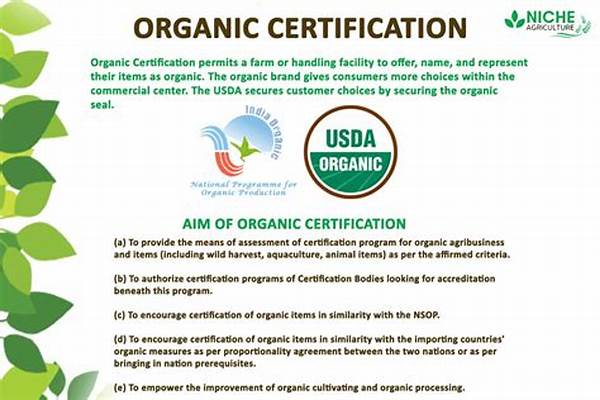In today’s rapidly evolving agricultural landscape, diversification of farm income is no longer just an option—it’s a necessity. Farmers face unpredictable weather patterns, fluctuating market demands, and increasing competition. By embracing diversification, they can secure a more stable financial future and mitigate the inherent risks of farming. Diversification not only provides financial resilience but also opens doors to new opportunities, transforming challenges into stepping stones.
Read Now : Best Organic Compost Materials
Understanding the Importance of Diversification
Diversification of farm income is crucial for ensuring the long-term viability of farming operations. By not relying solely on traditional crop or livestock production, farmers can buffer against market volatilities. Imagine a scenario where a single crop fails due to pest infestation. A diversified farm, which also engages in agritourism or organic produce, can withstand this setback and continue thriving. Further, diversification helps tap into niche markets, where higher profitability is achievable. Adopting this strategy propels agriculture into a realm of profitability and sustainability, encouraging innovation and creativity on the farm. As the global agricultural landscape evolves, diversification becomes the key to unlocking new revenue streams and fostering economic growth.
Strategies for Effective Income Diversification
1. Agritourism Ventures: Transforming farms into tourist attractions brings additional income and promotes rural development. By offering unique experiences, farmers can attract visitors and boost sales of farm products.
2. Value-added Products: Turning raw commodities into finished goods can significantly increase profit margins. For example, creating jams from homegrown fruits allows farmers to capitalize on the growing demand for artisanal foods.
3. Organic Farming: Embracing organic practices taps into a lucrative market that values sustainability and quality, providing a premium pricing advantage over conventional farming methods.
4. Renewable Energy: Installing solar panels or wind turbines generates electricity that can be sold back to the grid, creating a consistent income stream while promoting sustainability.
5. Lease Land for Events: Renting out farm spaces for weddings or events can provide substantial income with minimal investment, leveraging the farm’s natural charm and appeal.
The Challenges and Opportunities in Diversification
While diversification of farm income offers numerous benefits, it also presents challenges. Farmers may encounter steep learning curves, initial investment hurdles, and regulatory complexities. However, overcoming these challenges can lead to significant opportunities. With access to training programs and financial incentives, the journey becomes more manageable. Farmers should embrace new technologies and partnerships to optimize their operations. By actively seeking knowledge and forming strategic alliances, the roadblocks to diversification become manageable. In the long run, the rewards of a diversified approach—resilience, security, and prosperity—far outweigh the initial challenges.
Expanding Horizons through Diversification
The diversification of farm income creates pathways to expanded horizons. By exploring innovative avenues such as hydroponics or farm-based education programs, farmers can tap into new sectors and audiences. This strategic shift can catalyze rural economic development, introduce sustainable practices, and enhance community engagement. Moreover, diversification fosters a resilient agricultural environment adaptable to change. With multiple income streams, farmers can navigate economic uncertainties with confidence. The integration of technology and diversification enhances farm efficiency and productivity, paving the way for a sustainable future.
Steps Towards Successful Diversification
1. Research and Planning: Conduct comprehensive market research to identify viable diversification options. A solid plan increases the likelihood of success.
2. Evaluate Resources: Assess available resources such as land, labor, and capital, determining what can be leveraged for diversification.
3. Build Partnerships: Collaborate with agribusiness experts, government bodies, and other farmers to gain insights and share best practices.
Read Now : Eco-friendly Natural Insect Deterrents
4. Leverage Technology: Invest in modern agricultural technologies to optimize production and efficiency, reducing costs and increasing yields.
5. Flexible Adaptation: Stay open to change; adapt strategies based on market trends and consumer preferences, ensuring long-term sustainability.
6. Financial Management: Implement strong financial practices to manage cash flow and invest strategically in diversification opportunities.
7. Marketing Strategy: Develop a robust marketing strategy to promote new products or services, reaching broader audiences and maximizing income potential.
8. Monitor and Evaluate: Constantly review the performance of diversification initiatives to ensure they meet financial and operational goals.
9. Risk Management: Establish an effective risk management plan to address potential challenges that diversification may introduce.
10. Education and Training: Regularly update skills and knowledge to remain competitive and innovate within the agricultural landscape.
Looking Ahead in Farm Diversification
As we look ahead, diversification of farm income promises transformative potential. Farmers can leverage innovation to meet evolving consumer demands, environmental challenges, and economic uncertainties. By fostering a culture of continuous learning, investment, and creativity, farms can become hubs of sustainability, resilience, and profitability. This journey demands initiative and foresight, but the rewards are significant—a thriving agricultural sector ready to meet the future’s demands.
Conclusion: The Future of Agricultural Diversification
The future of agriculture lies in the successful diversification of farm income. It’s a dynamic process driven by innovation, resourcefulness, and adaptability. As traditional practices make way for diversified approaches, the agricultural landscape will flourish with opportunities. The continued embrace of diversification not only ensures economic stability but also encourages sustainable practices that benefit both the environment and society. By committing to this strategic evolution, farms will remain vital contributors to the global economy, nurturing communities, and ensuring food security for generations to come.



